| By: Paul S. Cilwa | Viewed: 7/26/2024 Occurred: 7/29/1961 Posted: 9/14/2022 |
Page Views: 1444 | |
| Topics: #GrandCanyon #MesaVerde #LittleColoradoRiver | |||
| At the end of July, 1961, I went on the longest trip I'd yet made: From Vermont to Arizona and back, without air conditioning. | |||
In 1961, after three years of trying to raise three children in rural Vermont by herself, my mom decided to move to a gentler clime. But where? There were two places on her list of possibilities. One was St. Augustine, Florida, where she had spent a couple years as a teenager; the other was Arizona, a place she'd long wanted to see but had never been.
To better make the decision, she informed us kids that we were going to make a road trip to Arizona. Why not? After all, though she'd spent most of her late husband's money on renovating our hundred-year-old house (fulfilling his dream), gas was cheap and there was no school in summer; it was the perfect time to hit the road.
This excited me greatly, because just a few months earlier I had discovered that gas stations, in addition to giving away free maps, had post cards one could fill out and send in to receive free vacation routings, with all the maps needed to get from here to there. I had already "made up" several trips to places I thought were distant and exotic, such as Nome, Alaska and Billings, Montana. Now I was able to put my "skill" in sending away for free stuff to good use; and a week or two before our planned departure, we had the route maps in hand.
We also had decent transportation, as Mom had purchased our first new car, ever. It was a metallic green Corvair station wagon, without radio or air conditioning but with "air cooling" (of the engine, not the passenger compartment) and a luggage rack on the roof.
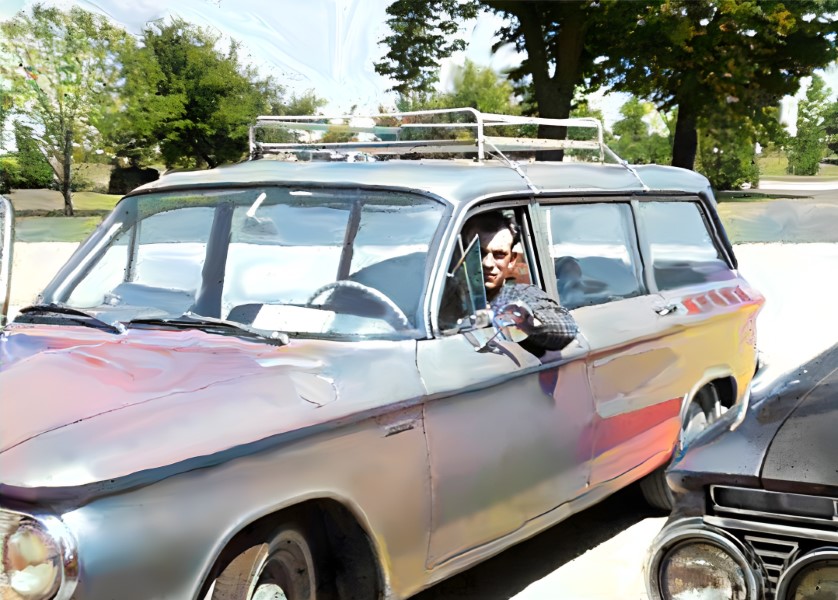
We also had a new man. Ray Larabie (not his real name) was the primary carpenter on the renovation of our house. He had been recommended by Mom's Cousin Cyril and stayed on when health reasons pulled Cyril off the job. Ray did everything: He wired the house for electricity, converted the gas lights to electric, replaced rotted clapboards with new, put up wallpaper inside and painted the outside.
He also provided company for Mom in the evenings when they drank a couple of beers and enjoyed adult conversation. He was also, I learned years later, a candidate for My New Father, in spite of his being ten years my mother's junior.
We left early in the morning of July 29, a bed made in the back of the station wagon (of course, there were no seat belts then and no seatbelt laws) for us kids, and our luggage lashed to the top of the Corvair. It's tricky to reconstruct our exact route from Vermont to Phoenix and back, because the Interstate Highway System had been barely started by 1961 and many of the local roads we took no longer exist. But our first stop was nearby St. Johnsbury, where my grandparents lived. My grandmother cried and cried at our leaving, which puzzled me because we were supposed to be back in two weeks. I hadn't been told that, if Mom found a place she liked, we might be leaving for good.
We crossed over Lake Champlain into New York State. I don't remember visiting Mom's favorite cousin, Malcolm, in Granville, on that trip; but other family members from the area (including Cousin Jairus and her daughters) had visited us just a few weeks before. Instead, we made as good time as possible, entering Pennsylvania before pulling over for the night in a motel.
As official trip photographer, I hadn't been impressed with the scenery that, so far, looked much like that at home. Besides, we hadn't stopped except to eat, and anything that looked interesting at the side of the road, whizzed by too fast for me to catch on film. However, my shutter finger itchy, I managed to take pictures of my sisters (and get one taken of me) that evening.

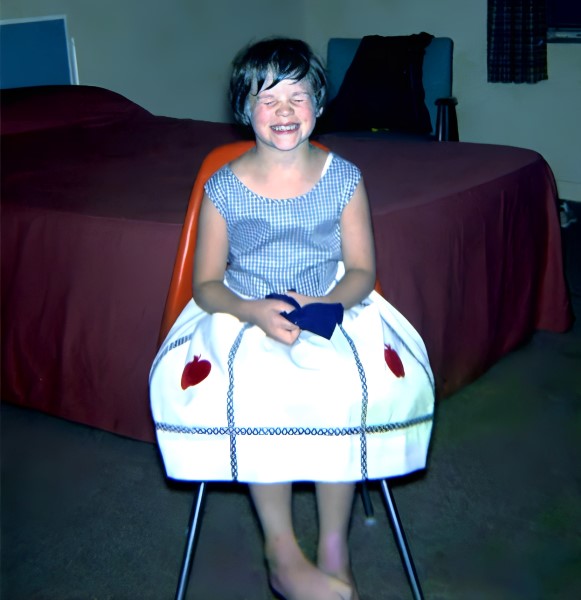
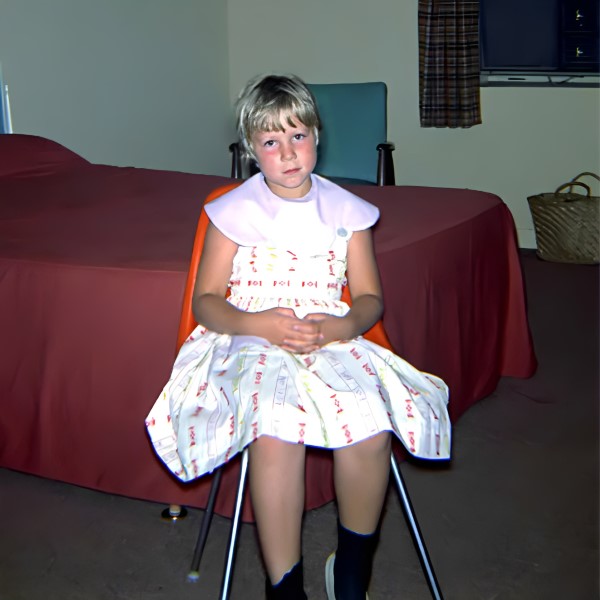
Judging by the photo Ray took of Mom and my sisters and me, none of us were having much fun yet.
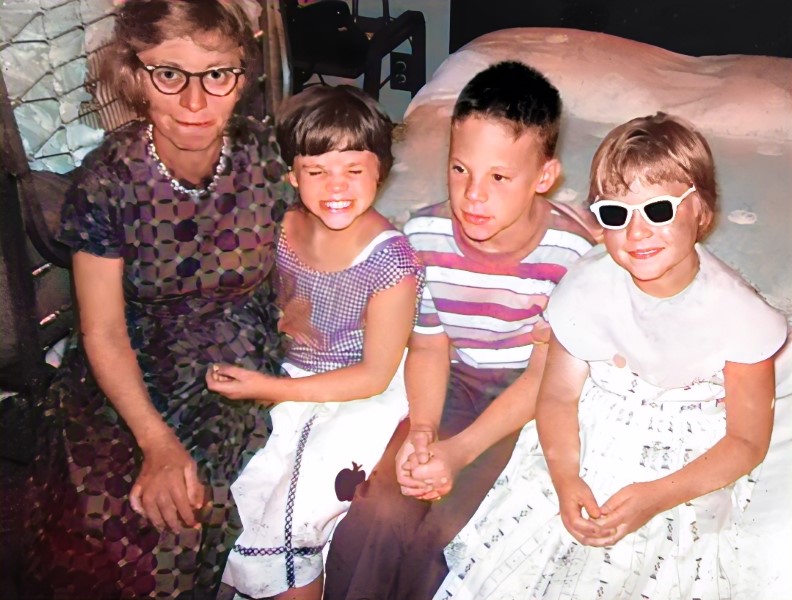
In the background of the above photo, you can see the fold-a-bed Mom had gotten for me. She slept with my sisters, I slept in the fold-a-bed, and Ray slept in the other room bed. On subsequent nights, I often bunked with Ray—folding cots not being universally available.
The next day took us past the factories of Columbus, Ohio and into Indiana, where we spent the night in Indianapolis. There was a go-kart attraction across the street from our motel room, but Mom wouldn't let us go—too late, too expensive (though she hadn't checked the price). So I spent much of the evening watching the go-karts race 'round and 'round the track, through the motel room window.
It was in St. Louis, Missouri, that we picked up the famous Route 66. —Not that I'd ever heard of it. The TV show Route 66 had first been broadcast the previous fall, but it was on CBS and the only channel we could receive carried programming from ABC. I'd never heard the song, either (though it's likely Mom and Ray had).
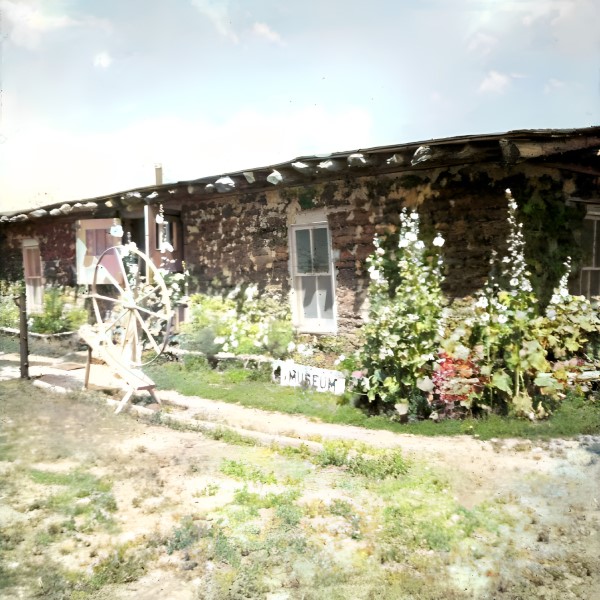
Route 66 had been the first attempt to construct a high-speed highway through much of the country, extending as it did from Chicago almost all the way to the Pacific Ocean at Santa Monica, California. More to the point, entrepreneurs had built shiny new motels all along the way; and there were diners and attractions to keep travelers fed and entertained until they reached their destinations.
Not that we stopped at many, for Mom was still anxious to get to Arizona. So, as the song points out, we passed through Joplin, Missouri; an eleven-mile stretch through Kansas; and finally into Oklahoma, where the landscape changed dramatically enough to catch my attention, especially the red dirt.

It was in Oklahoma that I saw my first Native Americans, though they were called "Indians" and were paid to sit outside a souvenir shop in traditional garb and allow tourists to have their pictures taken with them.
I was bemused by the father's eyeglasses and wrist watch, expecting the family to be true to the "cowboys and Indians" motif that was my only experience with these people who, in my school in the 1950s and '60s, had been given barely a footnote in history, mostly as props to welcome Columbus and to annoy settlers.
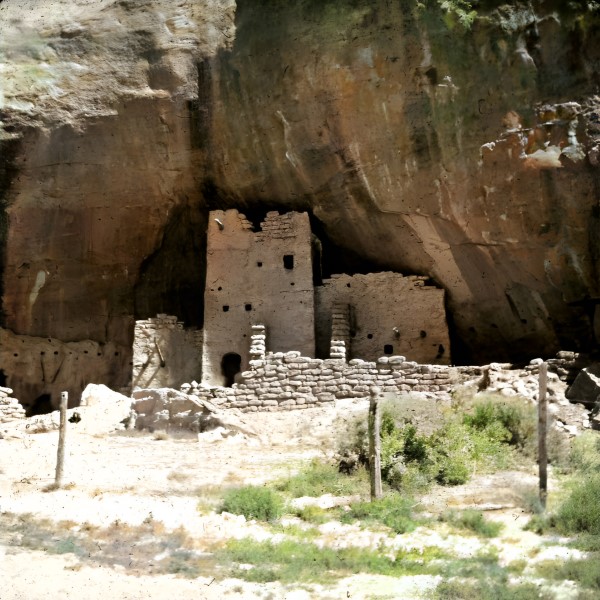
Even though I was only ten, I was quite uncomfortable at the idea that real people were being paid to display themselves and the remnants of their culture, like zoo exhibits.
At this point, for some reason we detoured up into Colorado, before heading south again. We did not go into Colorado's spectacular mountains—it would be almost 40 years more before I would see them. Instead we made a stop at Mesa Verde, which was in the process of being restored—a task that, now, reveals a far larger and grander pueblo that we were able to see in 1961.
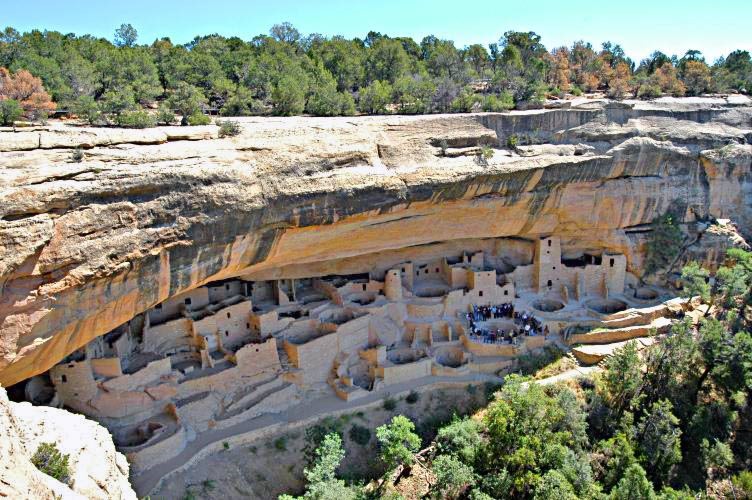
Mesa Verde in 2003
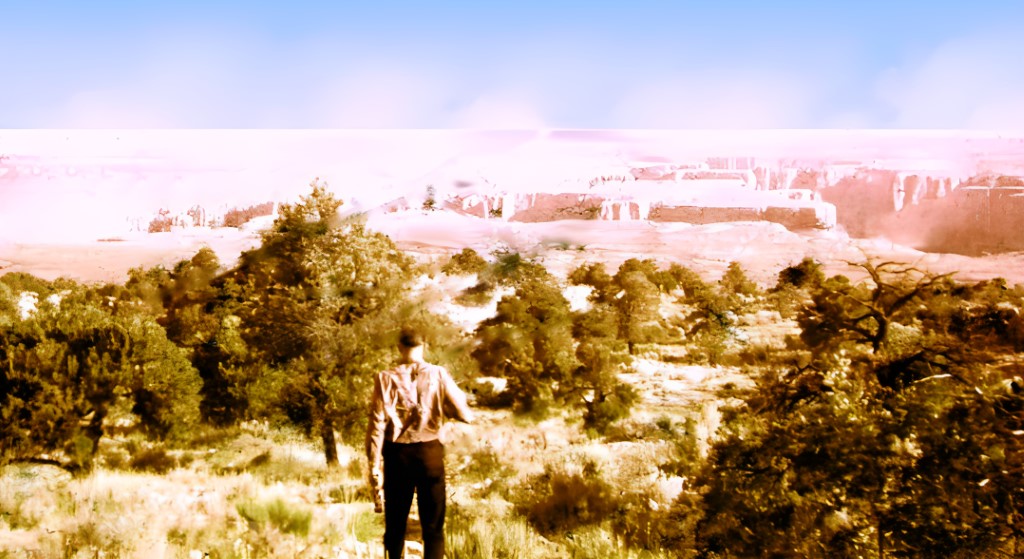
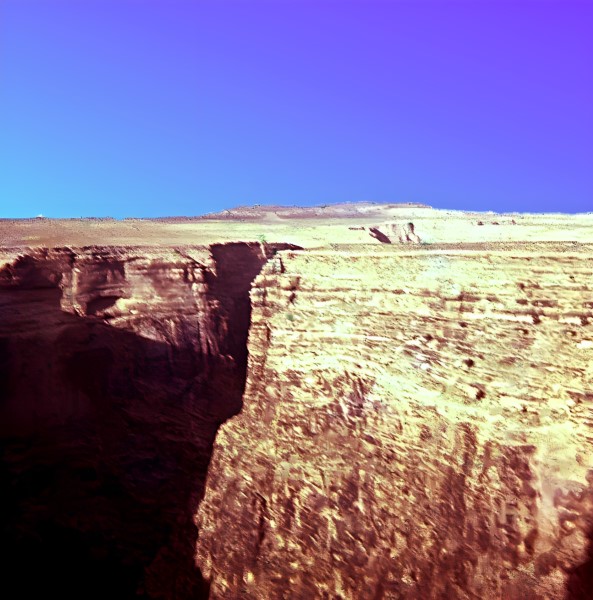
Again heading southward, we began to gain altitude and I saw, off the road, a great gash in the Earth. I had never seen anything like it, and insisted we stop. For once, we did so; and Ray and I got out to hike to the mysterious formation, which I was certain was the remains of some great earthquake.
It was not. It was the Little Colorado River Gorge, headwater of the principle tributary to the Colorado River that (I would later learn) carved the Grand Canyon.
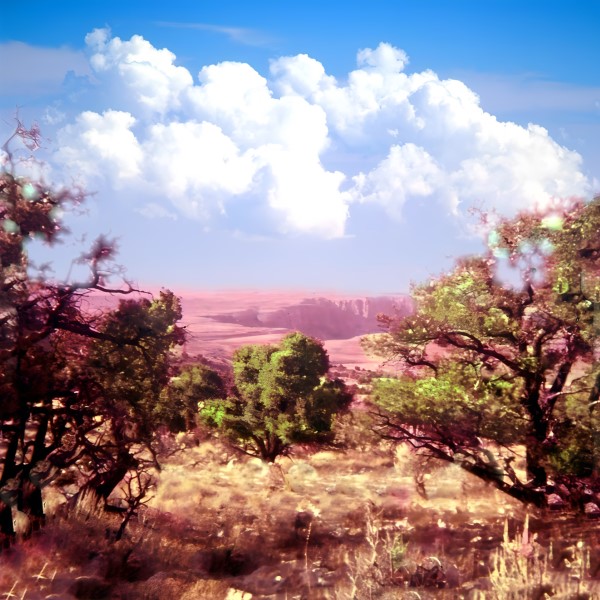
I can't overemphasize the effect the gorge had on me. For the first time in my ten-year-old life, I'd encountered a natural wonder that truly carried me out of myself and into the world of things greater than I.
Seen up close, the gorge was even more amazing. We stood on the very edge of it, a precipice suspended hundreds of feet above jagged, huge boulders waiting below. We couldn't actually see any water, though clearly a lot had rushed through here at some point in prehistory.
Continuing on our way, the road brought us into Flagstaff, a sleepy little town that inspired no photographs. (I don't remember noticing the San Francisco Peaks.) However, a few hours later we reached Grand Canyon.
I had no idea what to expect. Mom had told us it was beautiful, but since I had never seen it on TV or heard about it, and didn't really know what a "canyon" was anyway, you can understand I had no preconceived notions. We stopped briefly at the National Park entrance and were handed a flyer I didn't read. We drove down a quiet, well-paved road lined with low trees. Finally, we pulled into a parking lot, left the car, and walked to a lookout station.
There it was.
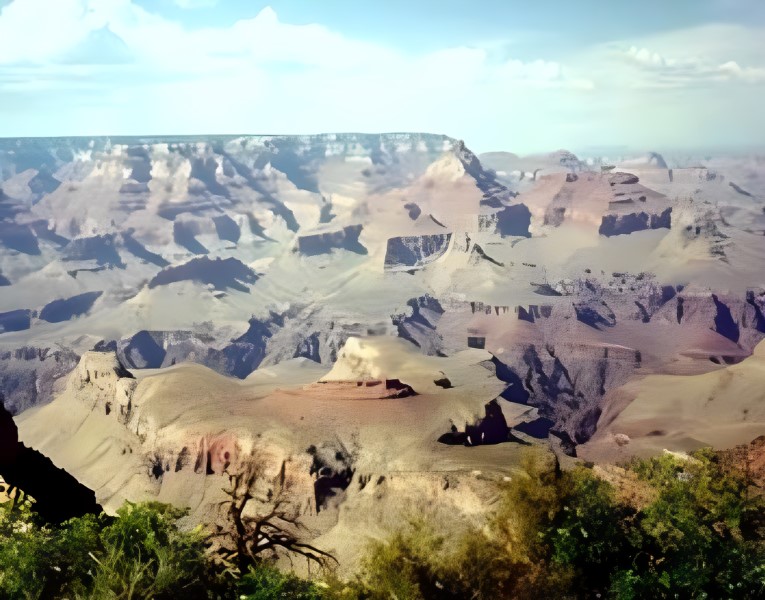
Even my little sisters gasped. But no one gasped louder than Mom, who, it turned out, was terrified of heights and found Grand Canyon to be the sum of all her fears. She wouldn't step onto the lookout platform (even though it was paved on solid rock) and insisted we kids stay back! I barely managed to take a picture with the Brownie when she whispered, "That's the Grand Canyon. Let's go." And she hurried us back into the car, and we left, spending the night a safe twenty miles away from the mile-high rim.
The next day we passed again through Flagstaff, stopping a few miles east of it to visit Walnut Canyon. This national monument is the location of a number of well-reserved Anasazi cliff dwellings, though they were better preserved sixty years earlier, when tourists began coming by for a picnic lunch, followed by the dynamiting of individual dwellings to make it easier to get to the relics left inside.

(The scientist who has locked his career to Walnut Canyon, insists on calling its former inhabitants the "San Aqua" Indians. It is admitted that their culture, including the way they made pottery and the clothes they wore, were identical to that of the Anasazi, who lived all around them. But by giving them a unique name, he has made himself the expert on one, specific, ancient Indian tribe and thus guaranteed himself a lifelong career.)
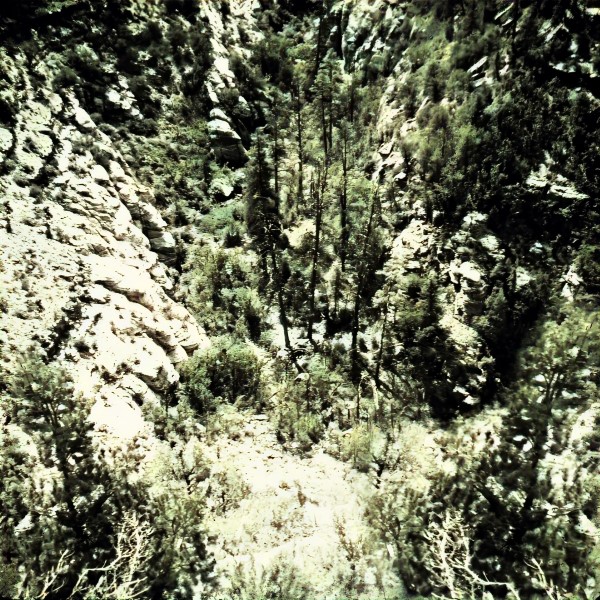 When
I returned to Walnut Canyon some forty years later, I was astounded at the
number of stair steps one has to descend to get to the dwellings. I didn't
remember any steps at all. Mom must have been terrorized; or perhaps she stayed
in the car—I have no pictures of her in Walnut Canyon.
When
I returned to Walnut Canyon some forty years later, I was astounded at the
number of stair steps one has to descend to get to the dwellings. I didn't
remember any steps at all. Mom must have been terrorized; or perhaps she stayed
in the car—I have no pictures of her in Walnut Canyon.
Although the real reason to visit was, of course, the remains of the Anasazi dwellings, I was far more interested in the sheer heights—and depths. Most of the pictures I took, were from the trail looking down to the floor of the canyon.
We then headed east on Route 66 to see the Painted Desert and the Petrified Forest, which marked the halfway point of the trip.
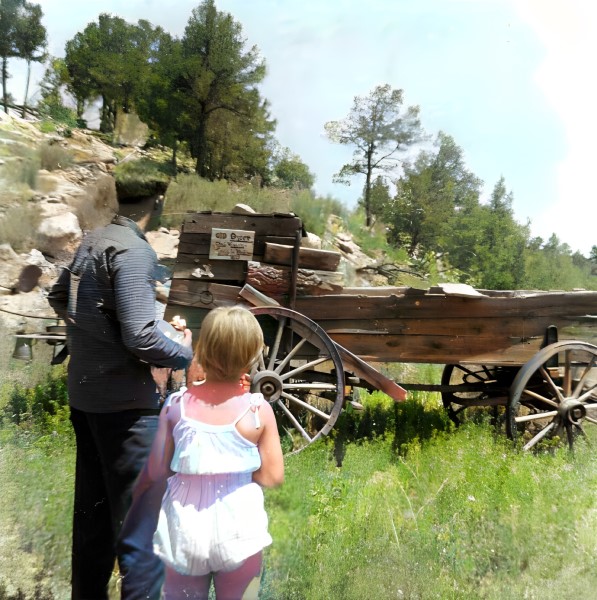
By the time we got to Phoenix, the mood of the trip changed. To begin with, we were now on the way home. For another, it was unbelievably hot.
Oh, yes, hot. We were in Phoenix at the beginning of August. The air was so hot it couldn't even rightly be called air; it was like some smothering blanket of gases that burnt when inhaled and left one breathless when exhaled. I'm sure Mom was surprised. Yet, she led us in an odd kind of sightseeing we hadn't done before, and which merited no pictures. We looked at a house.
Not Taliesin, Frank Lloyd Wright's celebrated house. This was a perfectly ordinary, and somewhat small, three-bedroom house whose owners were selling it. This was the first I'd heard that we might be moving to Arizona. I was shocked. I liked Arizona so far, but I loved our house in Vermont and didn't want to leave it. And Mary Joan was quite clear that she didn't want to move to this hot place, even if the house did have "air conditioning".
Mom, also must have realized how unsuitable Phoenix would be to live in, because we only "looked at" the one house. And we didn't spend time in Phoenix, but got right on the road for home.
But our route was designed to bring us home by an alternate path. We would not be retracing our steps. And so we spent our next night in Las Cruces, Texas, in the hottest motel ever created.
It had a "cooler", an evaporative unit into which we poured water, and which was supposed to blow out cooled air. It didn't. Or, if it did, it wasn't cooler enough to make a difference. Even today I remember that endless night, panting in my bed, coverless, drenched in sweat, unable to sleep.
As we continued northward into New Mexico, I realized that the heat wasn't limited to the motel. It was hot in our car. We had one glass jar of water to keep the five us of hydrated; and it was hot. Mom insisted that hot water was "better for you" than cold water, but we kids were not convinced. Still, we drank it, since there was nothing else. I tried to sleep, as the endless miles of sagebrush and yucca streamed by.
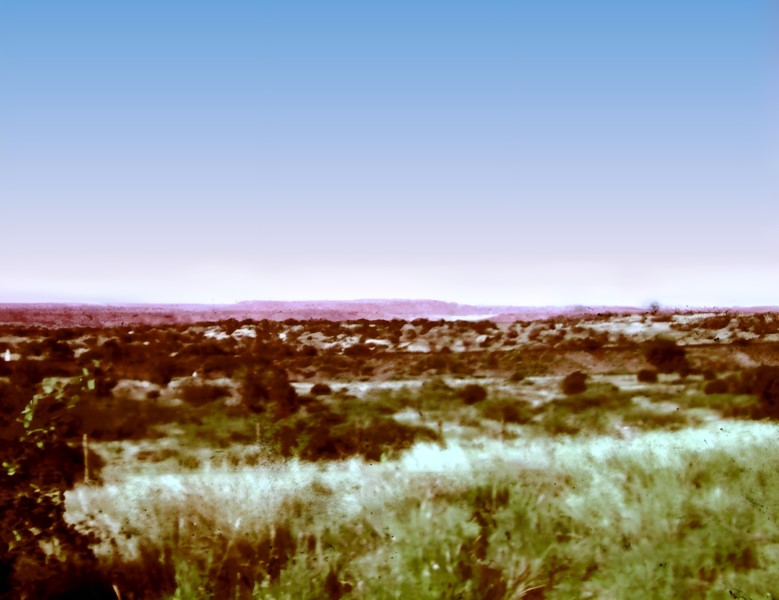
Every now and then, we'd come upon a sign warning us that, just ahead, was the "LAST CHANCE FOR GAS!". Ray would stop and fill up; we'd return to the road and almost immediately come upon another LAST CHANCE FOR GAS. Sometimes they varied the sign to say, LAST CHANCE FOR COLD DRINKS! We came up on Albuquerque about six miles past the last of these signs.
Albuquerque was memorable for several reasons. First of all, Mary Joan couldn't pronounce the name; she called it "Albaturkey" and Mom thought that was so cute, that Mom continued to call it "Albaturkey" through the next fifty years. Even on her death bed, if someone mentioned Albuquerque, she would correct them: "You mean 'Albaturkey!'" and laugh.
Secondly, we almost didn't sleep there at all; it was the first time on our trip that we encountered "No Vacancy" signs. Third, the motel we finally did find room at, had a swimming pool—the first on our trip. And fourthly, while my sisters and I were swimming in the pool, a dust storm came up.
Having been raised in Vermont, we knew nothing of such things. The sky grew dark, but not so dark as to make us think it was nightfall. But the wind picked up, and something started stinging my exposed skin, whenever I rose from the water. Mary Joan decided to run for our room, but Louise and I, thinking that whatever it was would pass quickly (and reluctant to leave the pool after a day of sweltering in the car), remained. Within seconds, we didn't have the option, as stinging clouds of sand whipped about us, tossing the poolside furniture into the air and blowing umbrella tables over. I directed Lou to come by me, at the overhanging corner of the pool deck where there seemed to be a modest shelter; we ducked underwater, rising only to catch a breath from beneath cupped hands, then to return below the surface where the dust had no bite.
It couldn't have lasted more than five minutes, probably less than that. When it was over, Lou and I were waterlogged and trudged back to the motel room. There were drifts of sand on the driveway, and some had even intruded beneath the doorway into our room. Yet, Mom and Ray were enjoying their Scotch, and seemed completely unaware that we had been in any danger or discomfort.
The next morning, as we left town, Mary Joan spotted a nice, white, cement building and pointed it out. "That's where we should have stayed last night," she said. It turned out to be the County Jail.
Perhaps it was that day, or the next, that an incident occurred in a restaurant. Louise remembers it best:
I remember something from a particular motel we stayed in that had a restaurant attached. I remember the restaurant because Mom and Ray were having some sort of fight at the dinner table. At the time I was told that they were fighting because he was flirting with the waitress. I completely did not get why that would be a problem, but I do remember Mom's eyes red with tears. Mary remembers this too.
At the same motel, I think, we were walking through the motel grounds maybe on our way to eat and I jumped on one of those animal-on-springs playground things. Don't know what'cha call it but you sit on the duck or whatever and it springs up and down or back and forth depending on the rider. Well I had a little help as Ray started bouncing me back and forth, back and forth and he was bouncing it much harder than a child ever could. It was going so fast my vision was completely blurred, my hands were sweaty and I was clinging to the hand grips for my life knowing I couldn't do it long. Unlike that idiot, I knew with all certainty if my hands slipped, that horse's head was coming right up in my face. Hard. I could hear him laughing. By the time he let me stop, I was crying and nearly hysterical and I remember this well, sporting a raging mad. Then he made fun of me for acting like a baby. Also Mom didn't defend me at all, like she didn't even see how serious a situation I had been in. I remember being very confused.
Ah, how well a taking a trip with someone can reveal their true colors. By the time we got back home, whatever romance there might have been was over. Mom indicated that Ray owed her money for his "share" of the trip. Ray countered that he only went along to help her drive, and didn't owe her anything. By nightfall, he had left in his own car for his home in southern Vermont; and that was the last we saw of him, except for one brief visit later that winter, after we had finally moved to St. Augustine, after all.
But let's dwell on the positive. The trip to Arizona left me with a fascination for this state that continues unabated. (I moved here in 1997, though I did not, at that time, intend to ever live in Phoenix!) I also continued to take photos, encouraged by the landscapes I had taken.
Route 66 remains, though a shadow of its former self; it was decommissioned in 1985. The motels are mostly run-down; the diners dusty, the two-headed snake attractions closed. And yet its remnants still remind us of the days when gas was cheap, and the whole family could hop in a car and head West.





